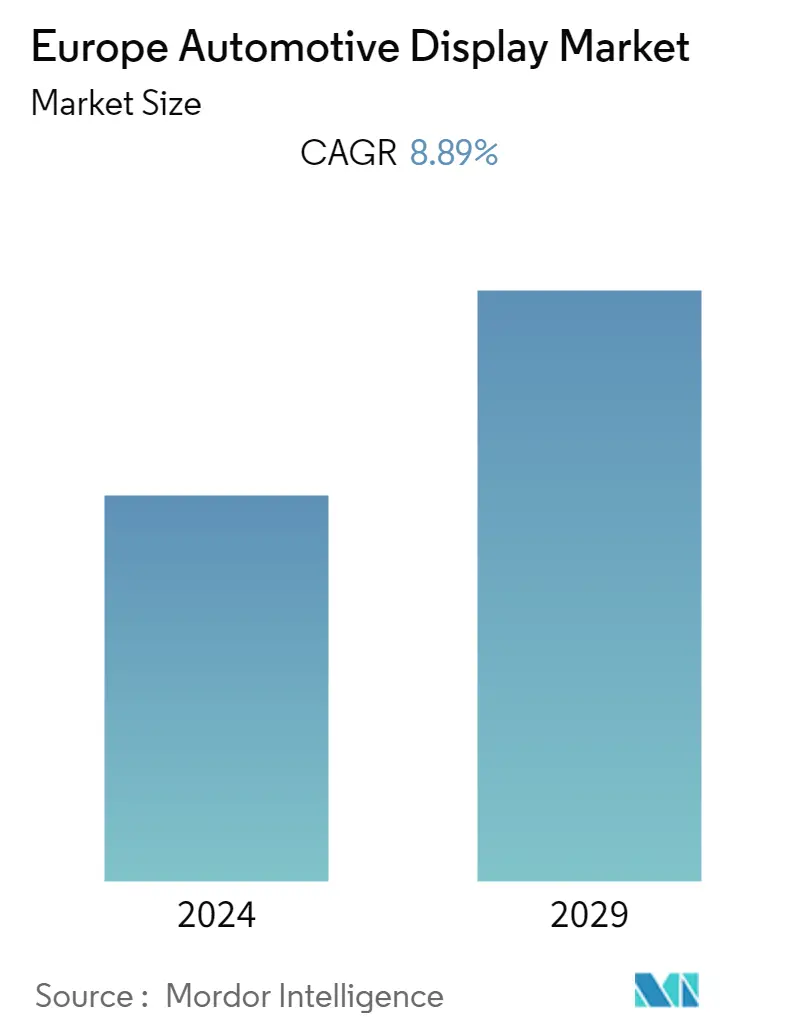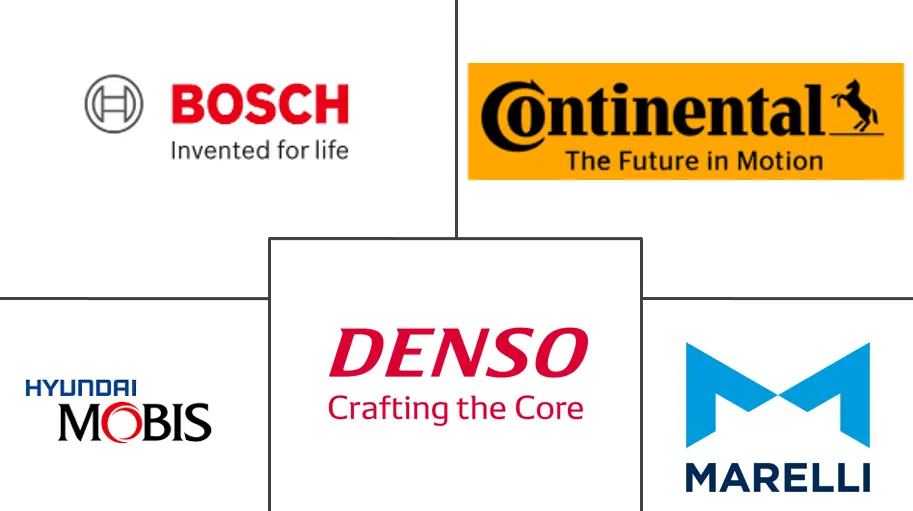Market Size of Europe Automotive Display Industry

| Study Period | 2019 - 2029 |
| Base Year For Estimation | 2023 |
| Forecast Data Period | 2024 - 2029 |
| Historical Data Period | 2019 - 2022 |
| CAGR | 8.89 % |
Major Players
*Disclaimer: Major Players sorted in no particular order |
Europe Automotive Display Market Analysis
The market is poised to register a CAGR of 8.89 % over the forecast period (2020-2025).
- Trends, such as autonomous driving, connected vehicles, augmented reality, and multiple usages of sensors and cameras, have made the display systems in vehicles more enhanced and are driving the auto display manufacturers to align themselves with these trends in the automotive industry. Automotive display manufacturers continue to work intensively on various advanced technologies for vehicle display systems with a variety of new functionalities that are expected to be adopted in future vehicles.
- With growing automotive navigation and connectivity systems in vehicles, auto visualization technology is playing a vital role in them, which led to the incorporation of interactive displays in few vehicles delivered/launched by prominent automakers, like BMW and Mercedes-Benz. These types of displays are gaining significant attention from display suppliers for implementation in their developing and manufacturing processes of display systems.
- Vehicle interiors are providing a futuristic digital user experience to the drivers. The number of displays in vehicles is continuously increasing, as OEMs try to stay ahead of their competitors to make their cars more attractive with advanced instrument clusters. For instance, in March 2020, Continental AG showcased its autostereoscopic 3D technology, which displays three-dimensional scales, pointers, and objects.
Europe Automotive Display Industry Segmentation
The automotive display market covers the latest trends and technological developments, and its demand by product type, technology, vehicle type, country, and the market share of major automotive display companies in Europe.
| By Vehicle Type | |
| Passenger Cars | |
| Commercial Vehicles |
| By Technology Type | |
| LCD | |
| OLED |
| By Product Type | |
| Center Stack Display | |
| Instrument Cluster Display | |
| Heads-up Display | |
| Other Product Types |
| By Sales Type | |
| OEM | |
| Aftermarket |
| By Country | |
| Germany | |
| United Kingdom | |
| Italy | |
| France | |
| Spain | |
| Rest of Europe |
Europe Automotive Display Market Size Summary
The Europe automotive display market is experiencing significant growth, driven by advancements in autonomous driving, connected vehicles, and augmented reality. These trends are prompting automotive display manufacturers to innovate and integrate advanced technologies into vehicle display systems. The increasing demand for automotive navigation and connectivity systems has led to the incorporation of interactive displays in vehicles from leading automakers like BMW and Mercedes-Benz. As vehicle interiors evolve to offer a more digital and user-friendly experience, the number of displays in vehicles is on the rise, with OEMs striving to enhance the appeal of their cars through advanced instrument clusters. Innovations such as Continental AG's autostereoscopic 3D technology exemplify the industry's push towards more sophisticated display solutions.
The market is moderately fragmented, with numerous local and global players like LG Electronics, Visteon Corporation, and Robert Bosch GmbH contributing to its development. While conventional display technologies continue to dominate, there is a noticeable shift towards newer technologies, including OLED displays, which are expected to gain traction over the next few years. The adoption of OLED displays is seen in luxury vehicles, such as the Cadillac Escalade, which features a curved OLED screen for optimal visibility. The market's evolution is supported by substantial investments in research and development, as companies like JDI Europe GmbH and Faurecia collaborate to enhance display systems. Facilities like Visteon Corporation's technology center in Germany further bolster the development of vehicle cockpit electronics and autonomous driving technologies, indicating a robust future for the automotive display market in Europe.
Europe Automotive Display Market Size - Table of Contents
-
1. MARKET DYNAMICS
-
1.1 Market Drivers
-
1.2 Market Restraints
-
1.3 Industry Attractiveness - Porter's Five Forces Analysis
-
1.3.1 Threat of New Entrants
-
1.3.2 Bargaining Power of Buyers/Consumers
-
1.3.3 Bargaining Power of Suppliers
-
1.3.4 Threat of Substitute Products
-
1.3.5 Intensity of Competitive Rivalry
-
-
-
2. MARKET SEGMENTATION
-
2.1 By Vehicle Type
-
2.1.1 Passenger Cars
-
2.1.2 Commercial Vehicles
-
-
2.2 By Technology Type
-
2.2.1 LCD
-
2.2.2 OLED
-
-
2.3 By Product Type
-
2.3.1 Center Stack Display
-
2.3.2 Instrument Cluster Display
-
2.3.3 Heads-up Display
-
2.3.4 Other Product Types
-
-
2.4 By Sales Type
-
2.4.1 OEM
-
2.4.2 Aftermarket
-
-
2.5 By Country
-
2.5.1 Germany
-
2.5.2 United Kingdom
-
2.5.3 Italy
-
2.5.4 France
-
2.5.5 Spain
-
2.5.6 Rest of Europe
-
-
Europe Automotive Display Market Size FAQs
What is the current Europe Automotive Display Market size?
The Europe Automotive Display Market is projected to register a CAGR of 8.89% during the forecast period (2025-2030)
Who are the key players in Europe Automotive Display Market?
Continental AG, Robert Bosch GmbH, Magneti Marelli S.p.A., Denso Corporation and Hyundai Mobis are the major companies operating in the Europe Automotive Display Market.

